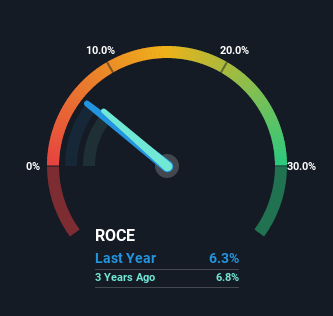- United States
- /
- Specialty Stores
- /
- NYSE:KMX
Here's What To Make Of CarMax's (NYSE:KMX) Decelerating Rates Of Return

Did you know there are some financial metrics that can provide clues of a potential multi-bagger? Amongst other things, we'll want to see two things; firstly, a growing return on capital employed (ROCE) and secondly, an expansion in the company's amount of capital employed. Put simply, these types of businesses are compounding machines, meaning they are continually reinvesting their earnings at ever-higher rates of return. In light of that, when we looked at CarMax (NYSE:KMX) and its ROCE trend, we weren't exactly thrilled.
Return On Capital Employed (ROCE): What is it?
For those that aren't sure what ROCE is, it measures the amount of pre-tax profits a company can generate from the capital employed in its business. Analysts use this formula to calculate it for CarMax:
Return on Capital Employed = Earnings Before Interest and Tax (EBIT) ÷ (Total Assets - Current Liabilities)
0.063 = US$1.5b ÷ (US$26b - US$2.0b) (Based on the trailing twelve months to February 2022).
Therefore, CarMax has an ROCE of 6.3%. Ultimately, that's a low return and it under-performs the Specialty Retail industry average of 18%.
See our latest analysis for CarMax

In the above chart we have measured CarMax's prior ROCE against its prior performance, but the future is arguably more important. If you're interested, you can view the analysts predictions in our free report on analyst forecasts for the company.
So How Is CarMax's ROCE Trending?
There are better returns on capital out there than what we're seeing at CarMax. The company has employed 60% more capital in the last five years, and the returns on that capital have remained stable at 6.3%. This poor ROCE doesn't inspire confidence right now, and with the increase in capital employed, it's evident that the business isn't deploying the funds into high return investments.
The Bottom Line
Long story short, while CarMax has been reinvesting its capital, the returns that it's generating haven't increased. And with the stock having returned a mere 37% in the last five years to shareholders, you could argue that they're aware of these lackluster trends. As a result, if you're hunting for a multi-bagger, we think you'd have more luck elsewhere.
If you want to continue researching CarMax, you might be interested to know about the 1 warning sign that our analysis has discovered.
While CarMax isn't earning the highest return, check out this free list of companies that are earning high returns on equity with solid balance sheets.
New: AI Stock Screener & Alerts
Our new AI Stock Screener scans the market every day to uncover opportunities.
• Dividend Powerhouses (3%+ Yield)
• Undervalued Small Caps with Insider Buying
• High growth Tech and AI Companies
Or build your own from over 50 metrics.
Have feedback on this article? Concerned about the content? Get in touch with us directly. Alternatively, email editorial-team (at) simplywallst.com.
This article by Simply Wall St is general in nature. We provide commentary based on historical data and analyst forecasts only using an unbiased methodology and our articles are not intended to be financial advice. It does not constitute a recommendation to buy or sell any stock, and does not take account of your objectives, or your financial situation. We aim to bring you long-term focused analysis driven by fundamental data. Note that our analysis may not factor in the latest price-sensitive company announcements or qualitative material. Simply Wall St has no position in any stocks mentioned.
About NYSE:KMX
CarMax
Through its subsidiaries, operates as a retailer of used vehicles and related products in the United States.
Mediocre balance sheet with limited growth.


